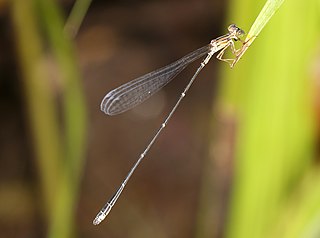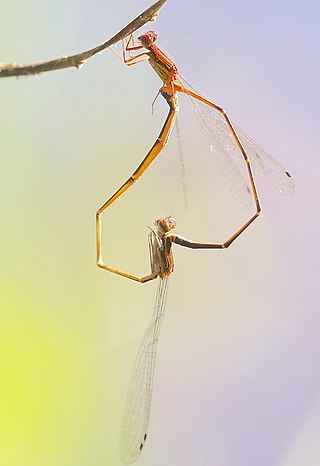Related Research Articles

Coenagrionidae is a family of damselflies, also known as pond damselfies, in the order Odonata and the suborder Zygoptera. The Zygoptera are the damselflies, which although less known than the dragonflies, are no less common. More than 1,300 species are in this family, making it the largest damselfly family. The family Coenagrionidae has six subfamilies: Agriocnemidinae, Argiinae, Coenagrioninae, Ischnurinae, Leptobasinae, and Pseudagrioninae.

The Platycnemididae are a family of damselflies. They are known commonly as white-legged damselflies. There are over 400 species native to the Old World. The family is divided into several subfamilies.

Elattoneura, the African threadtails, is a genus of damselflies in the family Platycnemididae. They were formerly placed in genus Prodasineura, but form a distinct clade. The adults are smallish and delicately built damselflies, and their males have very wide heads. The adults are typically found in sheltered locations beside or over running water, though a few prefer calmer water with much detritus. There appears to be two groups with differing habitat preferences. Those with pruinose faces and mostly blue eyes occupy watercourses in open terrain, while those with black or brightly coloured faces are found along forested streams.

Prodasineura, the Asian threadtails, is a genus of damselflies in the family Platycnemididae. All the Afrotropical species formerly in this genus are now placed in Elattoneura, the African threadtails. Dijkstra et al. (2014) moved the genus from Protoneuridae to Platycnemididae based on molecular phylogenetic research.
Protoneuridae was formerly considered a family of damselflies. Recent taxonomic revisions have classified the species previously placed in Protoneuridae into two existing families - Coenagrionidae and Platycnemididae, both in the superfamily Coenagrionoidea.

Platystictidae is a family of damselflies, commonly known as shadowdamsels. They look very similar to the threadtail damselfly family (Protoneuridae). They can mostly be found throughout Asia, Central America, and South America.

Isostictidae is a family of small to medium-sized damselflies restricted to Australia, New Caledonia, and New Guinea. It contains 12 genera and more than 40 species. Members of this family resemble species in the former threadtail family (Protoneuridae).
Epipleoneura is a genus of Neotropic damselflies in the Coenagrionidae family.

Coenagrionoidea is a superfamily of closed wing damselflies of the order Odonata found worldwide.

Nososticta is a genus of damselfly in the family Platycnemididae. Nososticta damselflies are found across a wide range from Africa, through Indonesia to Australia. They are commonly known as Threadtails.
Up until recently, Lindeniidae was considered a family of dragonflies occurring in Australia. It is no longer recognised.
Austrocorduliidae was formerly considered a family of dragonflies occurring in South Africa and Australia. Recent taxonomic revisions have classified the species previously placed in Austrocorduliidae to now be within the superfamily Libelluloidea.
Gomphomacromiidae was formerly considered a distinct family of dragonflies occurring in Chile and Australia. Recent taxonomic revisions have classified the species previously placed in Gomphomacromiidae to now be within the superfamily Libelluloidea.

Calopterygoidea is a superfamily of damselflies in the order Odonata.

Protoneura cara, the orange-striped threadtail, is a species of narrow-winged damselfly in the family Coenagrionidae, superfamily Coenagrionoidea. It is found in Central America and North America.

Philosinidae is a family of damselflies in the order Odonata. There are at least 2 genera and about 12 described species in Philosinidae, found mainly in southeast Asia.
References
- ↑ Dijkstra, Klaas-Douwe B.; Bechly, Günter; Bybee, Seth M.; Dow, Rory A.; Dumont, Henri J.; Fleck, Günther; Garrison, Rosser W.; Hämäläinen, Matti; Kalkman, Vincent J.; Karube, Haruki; May, Michael L.; Orr, Albert G.; Paulson, Dennis R.; Rehn, Andrew C.; Theischinger, Günther; Trueman, John W.H.; Van Tol, Jan; von Ellenrieder, Natalia; Ware, Jessica (2013). "The classification and diversity of dragonflies and damselflies (Odonata). In: Zhang, Z.-Q. (Ed.) Animal Biodiversity: An Outline of Higher-level Classification and Survey of Taxonomic Richness (Addenda 2013)". Zootaxa. 3703 (1): 36–45. doi: 10.11646/zootaxa.3703.1.9 . hdl: 10072/61365 . ISSN 1175-5334.